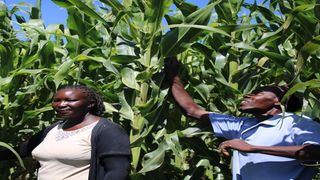
Terry Wakarindi and her husband Charles Macharia at their farm in Kalamton area, Nyandarua County.
| Waikwa Maina | Nation Media GroupNyandarua
Premium
How smart farming in Nyandarua is lifting livelihoods
Nyandarua County is easily the nation’s food basket.
The Kenya Economic Report 2020 rates it as the second fastest-growing county after Elgeyo-Marakwet. It’s also the second-best in economic activities after Nakuru County.
The Kenya Bureau of Statistics lists it as the seventh-best contributor to the GPD and the best county to invest in. There’s, however, a part of Nyandarua where food is scarce and families go hungry for days.
It’s a part of the county where civil servants consider it a punishment when they are posted there. Leshao Pondo and Kiriita Ward in Ndaragwa Constituency and Leshao Pondo Ward, which borders Laikipia County, are the ‘hardship’ areas.
After years of fruitless efforts to sell land in this area, landlords now work with brokers, who subdivide it to small plots that are sold to low-income earners desperate for a place to call home.
“Farmers from Shamata Ward, which is less than 10 kilometers from here, saw their potatoes and cabbages rotting at the farms for lack of markets, while their families and livestock starved due to unpredictable weather patterns,” says Ms Isabella Kamau, a resident of Karamton village at the Nyandarua-Laikipia border.
Mr Lucas Mwangi, who hails from the same area, says the world only knows about Kinangop, Ol Kalou, Kipipiri, Ol Joro-Orok, and the upper part of the Ndaragwa Constituency in Nyandarua.
“Images and videos that market Nyandarua to the world include the Aberdares and other productive areas. They use the highlands, healthy productive dairy cattle, farms flourishing with potatoes, cabbages, peas, and other vegetables. This creates the image that all Nyandarua residents are rich or live a good life,” he says.
Flourishing farm
But Mr Charles Macharia approaches it from a different perspective and says the dry parts of Nyandarua can also be productive.
“Our soils are fertile, what the residents need is support from the county, national, and development partners to make Leshao Pondo a productive area. It’s a warm place, meaning faster growth for food crops,” he offers.

Terry Wakarindi and her husband Charles Macharia at their farm in Kalamton area, Nyandarua County.
Unlike other dying farms due to the vagaries of the weather, Mr Macharia’s is flourishing with beans, maize, potatoes and peas.
He is among those who have embraced smart climate farming practices supported by the county government and its development partners under the Kenya Climate Smart Agriculture Project (KCSAP).
The weeds covering Macharia’s farm may convince a visitor that the owner must be very lazy, but no, they are part of climate-smart farming practices. The desert shrubs are greener here, with every resolve to grow taller.
There’s a flourishing acre of beans, a maize plantation, and an acre of Irish potatoes, surrounded by plots of spinach, kale, African Nightshade and Amaranth.
“I came here in 2000 from Othaya to join my father who was keeping livestock. Most of them died due to drought; we planted maize that barely survived after germination. Life was so hard until we embraced the climate smart farming technology and methods,” says Mr Macharia.
His wife, Ms Terry Wakarindi, offers: “Since ours is irrigation farming, we can plan when to plant to harvest at a time we have market guarantees. We plant maize and potatoes between January and February, which we harvest in May, when there’s scarcity in the market.
“We leave the land to rest before planting again around the same time the following year. We also practice crop rotation.”
Ms Wakarindi was a businesswoman who sold maize imported from Tanzania before she adopted the climate-smart farming methods.
“I was usually away from my family. I never had enough time for my husband and two children. But with the farming, the situation has changed; we spend more time together and I make more profits,” she says.
In one year of the programme, Ms Wakarindi says the family has bought three dairy cows, constructed a house, and paid school fees for her two children from profits.
The family is among the first beneficiaries of KCSAP that released Sh60 million to 72 self-help groups in Nyandarua in phase one. Some farmers benefitted from livestock-related support while others went for food production.
Ms Sarah Mwangi, a member of the group, says that apart from benefiting from modern and best farming practices, they were also supported with certified Irish potato seeds and peas.
“I specialise in peas and potato growing. Using the skills, the irrigation, and certified seeds, I have improved my potato production by 100 per cent. Last season, I got 100 bags of potato from an acre against a traditional harvest of between 40 bags and 60 bags by other farmers,” she says.
“You can multiply the number of bags by two now that we are packaging in 50-kilo bags, meaning I harvested 200 bags compared to 120 bags by farmers in other areas.”
Mr John Wachira, KCSAP county coordinator, urges farmers against growing any crop unless they have a market guarantee.
“If you don’t have a market for it, then don’t grow it. But with the modern farming technologies and proper timing, a farmer is always guaranteed of the market. Planting at an odd time of the year against traditional rain-fed farming, in phase one, we had three groups one in Kipipiri, Ndaragwa and iKinangop. We supported them with solar-powered irrigation systems and are all a success,” says Mr Wachira.
A solar-powered irrigation system like the one at Mr Macharia’s farm costs about Sh130, 000. Mr Wachira says the programme is now in phase three.




